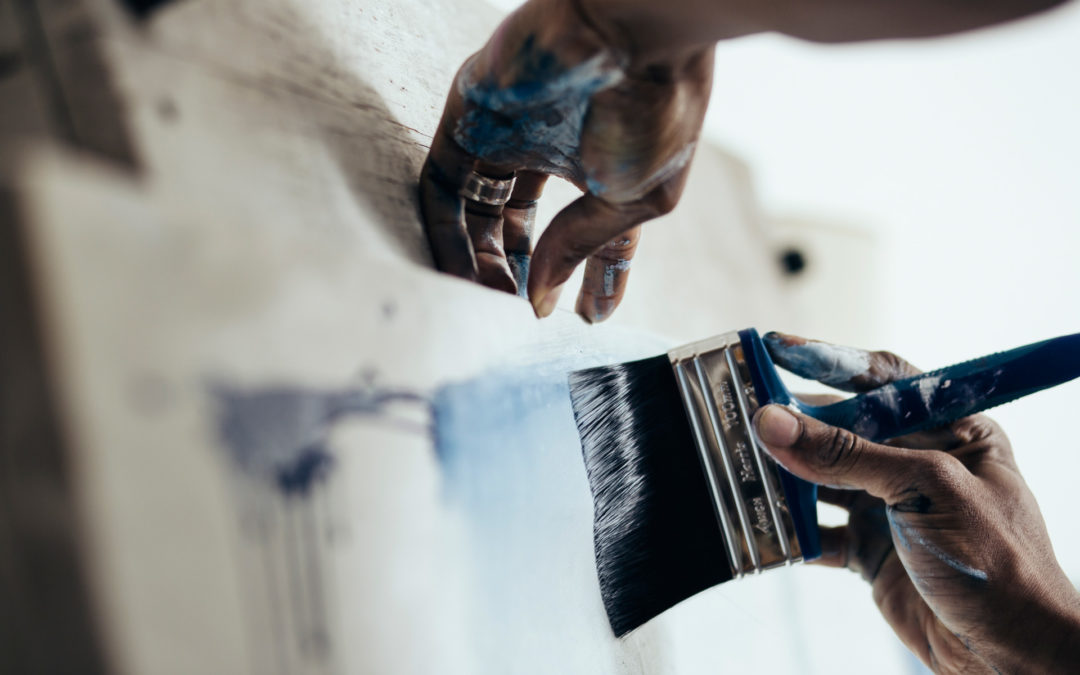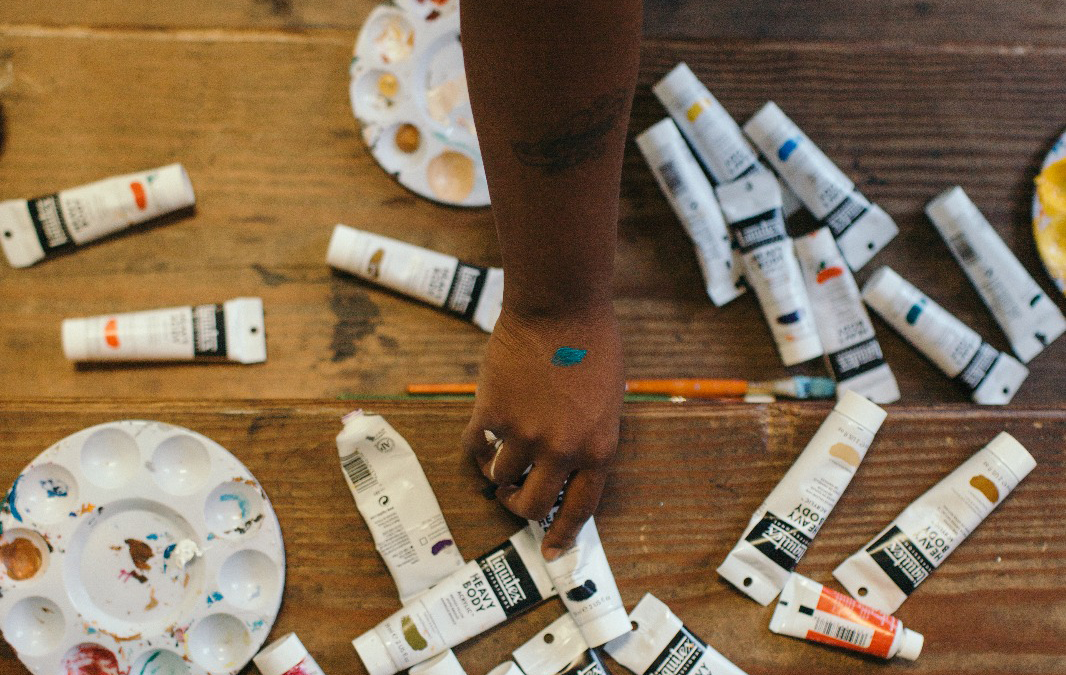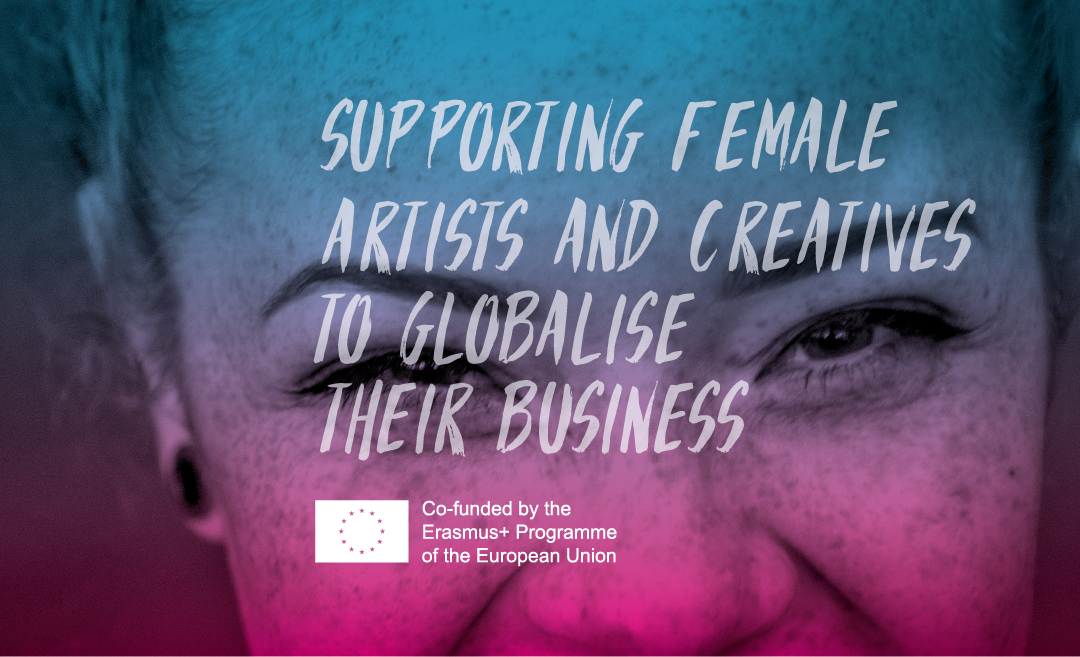
by admin | May 7, 2019 | News
by Anna Ochmann
In the mornings I love looking far, far away into the distance. At the treetops and branches graphically drawn with heavy strokes of black. At the shapes of graphite ravens perched on the tops. At the misty, blurry water painting of the woods in the distance. And closer. At the yellows of the siskins scouring in the bird-feeder.
And quite close. At the slender shape of the shiny teaspoon of sticky honey… The Saffron yellow of delicate crushed tulip petals, a folded page of the book a carelessly put down at the weary night.
Ethereal smudges of hot tea aroma flow over the bulky mug I’m holding in both hands.
I am lucky to be living in a place where civilization and nature blend. The big glass door of my workshop open to the fields and, further on in the distance, to the colourful stain of woods, which in winter is monochromatic, as if hazy, and in autumn saturated with a riot of colour.
This is my place. For painting, writing, creating. Drawing. Thinking.
And at the same time I live in a city, in one of the biggest Polish conurbations (Katowice urban area). Amidst a large-city hustle and bustle and with easy access to a vibrant cultural scene. With my favourite places to hang out with my friends or walk my dogs, magical jazz evenings, when music mingles with laughter and chats about everything and anything.
It is from this very mix of various elements that most of my best, most creative ideas are born. And how does it work with other ‘creative’ people?
The report ‘WeTransfer IDEAS REPORT’ is an attempt to answer this question and it summarizes the results of a survey carried out in 143 countries in June 2018, in which over 10,000 creative people took part (after all, who wouldn’t use wetransfer?). Is it possible to find a common denominator for creative people, and if so, what factors influence it? And is it possible, having this knowledge, to develop consciously one’s creativity, or create conditions for its development?
When reading this report, I raised my eyebrows with surprise on a few occasions and I smiled a few times thinking ‘yes, this is all me’. Here are a few questions from the report:
‘When is most creative part of your day?’ – ‘it’s never the same (33%)’. Just like with me. Sometimes it is this fleeting moment when the dawn mingles with some blurred dreams, sometimes when I cook pasta, and sometimes when I am drawing, sometimes when I laugh happily with my friends…
‘What inspires your best ideas’ – “talking with friends” (45%), “book and magazines” (45%), “travel” (38%), “music” (35%) “nature” (34%). – this is all about me…
‘Where do you get your best ideas’ – “at work/at my desk/at my studio” (47%). This is me – most often when I freeze with a paintbrush in my hand or in this microsecond when I am looking for the right key on the keyboard of my computer while typing something.
‘How do you usually record your ideas’ – “on pen and paper” (40%) – this is me again… (all these little pieces of paper on which I hurriedly jot things down, or on other occasions write down very slowly and carefully, all those notes on which I cross things out, doodle or scribble…)
‘To be really creative I need’ – “quiet and silence” (65%) – although I do need sometimes the chatter of a Cracovian cafe…
It seems to me that creativity, those spells of creative moments, are usually unpredictable, yet perhaps there are moments or situations that are conducive to it?
The report is available here: https://wepresent.wetransfer.com/story/ideas-report-2018/#/

by admin | Mar 14, 2019 | News
by Anna Ochmann
In July 1999 I received my diploma of graduation from the Academy of Fine Arts. The feeling of happiness mixed with the overwhelming exhaustion, my pride resulting from graduating from Cracovian artistic academy was coupled with the feeling of hopelessness – what should I do now? The very good grade on my diploma somehow tasted like a hospital drip.
A few month later. A train from ‘university’ Krakow to home Zabrze. In my head I feel an explosion, and suddenly I find myself surrounded with blobs of dirt with freckles of dry chewing gum. All shades of grey mixed in organic forms of floor-cloth traces. The stench is worst though. Nauseous… The stench of multilayered, many-day dirt – dust brought on passengers’ boots, and, most of all, the ingredients of sandwiches pompously called hamburgers, so popular in the ‘new’ Poland (the one after 1989), that were dropped on the floor. The smell of pickled gherkins, onion, ketchup… I hold fast to a leg of 2nd class carriage seat, which is padded with faded pleather. I cannot stand up without a splitting headache. My body said enough – in the last few months I slept too little and worked too much…
It was time that I come back to with a reflection – how distant the university life, the discussions about the ‘essence of beauty’ or ‘the experience and symbolism of light in the Middle Ages’ were from the reality of my professional life then and later. First, still as a student, for advertising agencies, and later as a freelancer.
Freelancer. A word that was new in Poland at that time, and perhaps still is. A word that sounds strange. Marked with a stigma of something ominous. The word that I loved for the feeling of freedom, independence, challenge. The word I hated for insecurity, temporariness, a kind of wobbliness. I can remember both the tears when I wasn’t paid for many days of my work (the times of unwritten contracts) and the wings I got when the stand I had designed drew attention of crowds at an international fair. The frustration caused by long days over concept drawings, over the drawing board, sharpening the pencils (the computers were yet to come), the smell, one of its kind, of putty rubber, but also the salary handed over in a thick blue envelope (I didn’t have my bank account back then). I remember my first negotiations, the first fair stand, designed by me from scratch for the fair in Dresden (Germany), as well as the long hours spent on sticking up square metres of foil, as it arrived too late (with a bunch of randomly found helpers, virtually grabbed from the street). The attempts to organise their work, explaining to them their duties, the race with time. And painstaking punching the air bubbles in the foil with a pin. And then circling the city in the middle of the night to find shop windows with mannequins – to get the contact details for the owners. Then waking them up with the call from a phone box to beg them to lend us their plastic figures for 4 days of the fair, as ours hadn’t arrived…
I can also remember my first trip to Brussels. Cultural differences at work (most of all the language – the first thing I’ve learnt is how difficult it is to express your ideas precisely in a foreign language, especially when talking to people who are not native speakers). The satisfaction from my first presentation. Further paintings sold.
The university had not prepared me for all that. Neither to deal with clients nor for teamwork. Nor for the ability to assess the value of my work or selling my skills. Nor to cope with stress and overwork, with working under pressure (including time pressure). Nor were we taught about intellectual property or copyright law. Still I know I studied at the best time possible, at the best university, and I had the best teachers, and great, inspiring colleagues. I still go back to Art Theory, Sculpting classes, Drawing classes, or long discussions about art, sitting in a cafe and sipping one cup of tea for five hours.
Writing this short text I am wondering if and how one can prepare a young woman for this kind of work in a globalised world. Work in the creative and culture sectors – which, by definition, are without any limits or borders, and, at the same time, are heavily set within these borders when it comes to culture. And, most of all, how can one prepare her to work as a freelancer?

by admin | Feb 5, 2019 | News
Global FemArt Consortium launches a survey, addressed to female artists and creatives, to explore needed key competencies (knowledge-skills-attitudes) to activate or mediate a process of internationalization for products and services.
Your contribution is extremely important and valuable to us! Thanks to it, we will able to develop and activate an effective and successful pilot training program. Don’t miss the opportunity to participate in Global Fem Art training sessions and do not forget to include your email address in the contact information so we can let you know what is coming up.
Enjoy the survey! https://goo.gl/pjxoAH

by admin | Jan 14, 2019 | News
Our website is finally online!
Here you can find:
- info about the project
- products and outputs
- the partnership involved
- news about the project and related topics
Enjoy!



